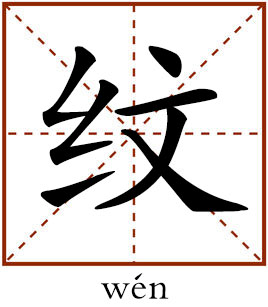Motif

Generally, this character is pronounced as wén, meaning patterns, motifs or designs. When pronounced as wèn, this character is interchangeable with another character that refers to the cracks on the surface of porcelain.
古代玉器纹饰简介
gǔ dài yù qì wén shì jiǎn jiè
This is a brief introduction to the design of ancient jadeware.
Jadeware has been one of the most impressive objects of appreciation in China surviving from the Neolithic Period (c. 3,000–2,000 BCE) onwards. Designs of jadeware have varied with time. They can be used as a standard to distinguish the date of jadeware in China’s history.
Originally, Neolithic jadeware was simply carved with mask decorations. In the Shang Dynasty (c. 16th–11th century BCE), the jade carving craft made a noticeable advance. There were small figurines, masks and animals carved within the jadeware.
The manipulation of jade within the Zhou Dynasty (c. 11th century–771 BCE) made a turn towards looser, less-systematic types of designs, with zoomorphic decor that transformed into more abstract meandering patterns. During the Shang and Zhou dynasties, popular motifs were known as the dragon and the Taotie (a legendary monster featuring large, protuberant eyes) motifs. Tang dynasty style jade adopted techniques used in painting, creating detailed images of birds and other animals. Given the fashion of the Song (960–1279), the design that featured the dragon and the phoenix, images that symbolized prosperity and good fortune, were much admired.
Jade craftsmanship reached its peak during the period of the Qing Dynasty (1644–1911), a time during which China directly controlled the regions of the Central Asian jade-yielding areas. Novel patterns in jade sculpture emerged and developed in large quantities, such as images of insects, plants and landscapes. The finest Qing dynasty jade carvings were often assigned to the reign of the Qianlong Emperor. Typical of this era are vases with lids and chains carved from a single block of stone, vessels in shapes of antique bronze with pseudo-archaic decoration, mountains and brush pots for the desks of scholars.
edited by REN GUANHONG

 PRINT
PRINT CLOSE
CLOSE